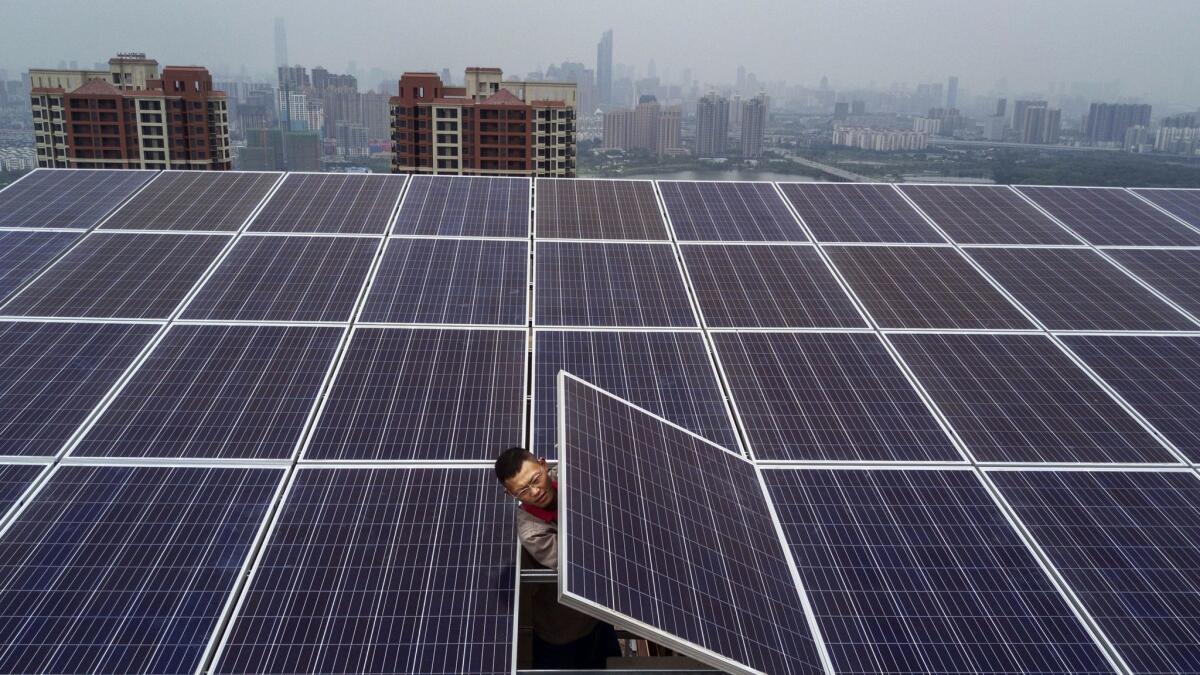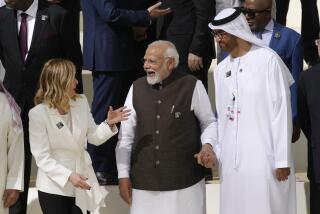China is getting serious about fighting climate change at home. Abroad, its investments tell a different story

China is the world’s largest greenhouse gas emitter. (June 1, 2017)
- Share via
Reporting from BEIJING — Pakistan’s Thar region is a swath of desert in the country’s south long associated with poverty, drought, famine — and coal.
Now, with some help from China, it could soon power the country.
For the record:
10:20 a.m. June 3, 2017This article incorrectly identifies Frank Umbach as associate director of the European Center for Energy and Resource Security. He formerly held that title, but is now research director at the center.
China has signed billions of dollars in agreements with Pakistan to help the country alleviate its chronic energy shortages, primarily by burning coal. New projects will involve mining billions of tons of the fossil fuel annually in the region — home to some of the world’s biggest coal deposits — and building five new coal-fired plants to help power Karachi, a metropolis of 20 million people about 300 miles away.
Yet critics say they could also fill the country’s air with noxious smog for decades, exacerbating already intense public health crises and contributing to climate change.
China, the world’s biggest greenhouse gas emitter, has in recent years emerged as a global leader in climate action. The country’s use of coal — considered the single biggest contributor to anthropogenic climate change — has dropped every year since 2013, as its investments in renewable energy, especially wind and solar, have soared.
The Chinese are mostly exporting these quite modern coal-fired power plants. So compared to what might otherwise be operating ... these might be cleaner.
— Deborah Seligsohn, UC San Diego
California Gov. Jerry Brown will travel to China this week for an international summit on clean energy, underscoring the country’s growing role as a center of gravity in fighting climate change.
Yet China’s domestic progress belies a spottier record abroad. It is the world’s largest exporter of coal-related financing and equipment. Its state-owned companies — backed by state loans and hampered at home by tightening environmental regulations — are involved in nearly 100 coal-fired power projects abroad, in countries including Pakistan, India, Indonesia, Vietnam, Mongolia and Iran.
“What’s going down here is, there’s an overall mandate from the government for companies to go carry out projects abroad, and export their goods — and it’s the most powerful state-owned companies that end up doing that,” said Lauri Myllyvirta, a Beijing-based coal and air pollution expert at Greenpeace. “And so what we’ve seen really reflects the power of the coal industry versus the renewable energy industry within China. What we’ve primarily seen going out of China is coal-fired technology.”
For decades, developed nations including the U.S. helped fund the construction of coal-fired power plants in the developing world. Yet in November 2015, the Organization for Economic Cooperation and Development’s 34 member states — including the U.S., Japan and many European countries — agreed to restrict financing for the vast majority of overseas coal-fired power plants. The World Bank in effect stopped funding new coal projects for developing nations in 2013.
China, which is a member of the World Bank’s governing organization, but not the OECD, has yet to adopt a similar policy.
The scope of China’s coal-related exports — and whether they are even cause for alarm — is difficult to assess, according to Deborah Seligsohn, an expert on environmental governance at UC San Diego.
In addition to coal-fired power plants, China is also building hydropower, natural gas, nuclear, wind and solar projects around the world. Last year, its foreign investment in renewables reached $32 billion, a 60% increase over 2015, according to the Institute for Energy Economics and Financial Analysis. Its exported coal plants tend to be more efficient — and could be more environmentally friendly — than what could be purchased elsewhere for the same price.

“The Chinese are mostly exporting these quite modern coal-fired power plants,” she said. “So compared to what might otherwise be operating in these countries, these might be cleaner, not dirtier.”
“I think it’s hard to know whether the Chinese are having that huge an impact on what the fuel choice is in third countries,” she continued. “I don’t think that’s been proven.”
Beijing, grappling with slowing economic growth at home, has pushed state-owned firms to seek new markets abroad. In 2013, President Xi Jinping announced “One Belt, One Road,” a massive project that involves infrastructure construction and trade expansion in more than 60 countries across Asia, Europe, northern Africa and the Middle East.
From 2001 to 2016, Chinese firms were involved in 240 coal power projects in those countries, many of which rank among the world’s most vulnerable to the damaging effects of climate change, including heat waves, floods, droughts and melting glaciers.
When the projects are complete, they’ll have a total generating capacity of 251 gigawatts, according to the Global Environmental Institute, a Beijing-based nonprofit. (By contrast, only about 70 gigawatts of solar power was installed globally in 2016. About half of that was in China.)
China’s rhetoric has changed in recent years. In September 2015, Xi, in a joint statement with President Obama, agreed to “recognize the importance of mobilizing climate finance to support low-carbon, climate-resilient development in developing countries.” And last year, China signed the Paris agreement, a historic accord in which 195 countries agreed to curtail climate change by limiting global warming to no more than 2 degrees Celsius above preindustrial levels.
(President Trump tweeted Saturday that he would make a “final decision” on whether to withdraw the U.S. from the accord this week, and is said to be leaning toward doing so.)
Yet since 2016, China has announced, or begun developing, several new coal projects throughout the world, according to the online magazine Chinadialogue and the nonprofit CEE Bankwatch Network. The projects’ total capacity — more than 52 gigawatts — is more than that of planned coal-plant closures in the U.S. by 2020.
China’s tough domestic standards don’t apply to exports, and few of the projects have clarified their emissions standards. Public information on the projects is scarce.
“There’s hardly any official data on the Chinese side,” said Frank Umbach, associate director of the European Center for Energy and Resource Security at King’s College London. “They’re not willing or interested [in providing it] for obvious reasons.”
Pakistan stands to reap huge rewards from Chinese initiatives. In 2013, the two countries signed the $54-billion China-Pakistan Economic Corridor, a project so vast — involving transportation infrastructure, economic zones and a total of 19 energy projects — that a Pakistani newspaper called it a “Marshall Plan for Pakistan,” referring to the U.S. effort to rebuild Europe after World War II.
The energy projects include several power plants, three-fourths of which will be coal-fired. An estimated $5.8 billion worth of coal power projects are expected to be completed across the country by 2019.
The country has a dire need for inexpensive, efficient power — only 67% of its nearly 200 million people have access to electricity, according to the World Bank. In many ways, coal fills the bill — it’s abundant, cheap and reliable.
Yet the country’s embrace of coal could come at a huge environmental cost. Pakistan currently accounts for less than 1% of total global carbon emissions annually, according to the World Bank, but its emissions are increasing at 3.9% annually.
Pakistani officials say the coal plants will use top-flight emission-reducing technology. But critics say that even the cleanest coal-fired power plants still pollute; many of Thar’s nearly 100,000 people will need to be relocated; and the region has massive solar power potential, making the new coal projects unnecessary.
“No sane person would want electricity from dirty energy sources, even though supercritical technology is used,” Malik Amin Aslam, a former state minister for the environment in Pakistan, told Reuters. “These plants, not being completely free of carbon emissions, will still harm the public health and the country’s environment.”
Xu Yuan, a climate change expert and professor at Chinese University of Hong Kong, said that China’s leaders have learned to prioritize environmental issues when promoting hydropower projects abroad — public backlashes have derailed high-profile projects in Myanmar and Honduras.
“But coal-fired power stations are different — they’re not going to kill people immediately or directly,” he said. “They emit pollution, which adds risk to the entire population. In that sense it’s quite different.”
Xu added that China’s government began focusing on domestic environmental issues only after years of intense pressure at home and abroad. Many of China’s coal-fired power plants overseas — and the companies overseeing them — simply don’t see environmental protection as an obligation.
“In my understanding of how the Chinese system works, you have to make sure the problem is visible, not just potential,” he said. “And that’s very sad.”
For more news from Asia, follow @JRKaiman on Twitter
ALSO
Man investigating Chinese company tied to Ivanka Trump is arrested, and two others are missing
China says granting Ivanka Trump trademarks was unrelated to her dinner with President Xi
More to Read
Sign up for Essential California
The most important California stories and recommendations in your inbox every morning.
You may occasionally receive promotional content from the Los Angeles Times.










